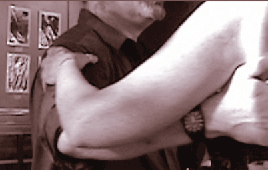
HOME
PUBLISHER’S CORNER
“A SENSORY BRIDGE TO GLOBAL CULTURE”


Advertise in:

AS WE INAUGURATE
TANGO LIFE & NEWS
TAKE ADVANTAGE OF OUR EXCLUSIVE
ONE-TIME OFFER TO PLACE YOUR AD HERE
FREE DURING NOVEMBER!
ADVERTISERS, DON’T MISS THIS CHANCE TO FEATURE
YOUR BUSINESS IN PREMIUM WEB SPACE
THAT WILL BE SEEN BY A GLOBAL AUDIENCE!
FOR DETAILS.
312.287.8406
AS A SPECIAL INTRODUCTORY BONUS, YOU’LL ALSO RECEIVE A DISCOUNT ON ADS PLACED THROUGH JANUARY 6, 2011.

THE S P A C E
BETWEEN US
CONTINUES...CLICK HERE
THE S P A C E BETWEEN US
PSYCHOLOGICAL PERSPECTIVES
ON THE DANCE OF RELATIONSHIP

CONTINUED
TANGO METAMORPHOSIS

The dynamic quality of Argentine tango draws a steady steam of new worldwide devotees who are transformed by its benefits, many of whom begin to employ the dance as personal life philosophy and tool for self-discovery. Some who have experienced tango’s power in their own lives have proceeded to move tango out of the social context and begun utilizing it as a therapeutic intervention to assist others.
While dance/movement therapy itself is young as a profession and area of research, tango as a form of therapy is in its early infancy. The First International Conference on Tango Therapy took place in Rosario, Argentina in July, 2008, PRI’s The World 23 aired a report on the conference describing the event as largely attended by researchers, kinesiologists, physical therapists, and psychologists.
The Argentine tango could be considered a universal dance due to its multicultural roots and international popularity. While styles and personal preferences allow for a multitude of variations, the essence of tango remains: physical connection through improvisation. Partners create one unified dance while maintaining each person’s individual role.
The experience of resonant connection with one’s tango partner is perceived by many as blissful and transcendent. Some tangueros have even turned tango into their spiritual practice; others have used it as a source of understanding the nature of masculine and feminine energies. Relational conflicts may rise quickly to the surface through tango, and transformation is required in order to progress. DMTs and psychotherapists have begun to use tango as a framework for therapy, and tango’s therapeutic potency is starting to gain high profile recognition.
The ground is fertile for further research on the therapeutic value of Argentine tango as a tool for interpersonal growth. My research has opened the door to even more questions such as: How effectively does the tango experience reflect one’s interpersonal life off of the dance floor? Is a person’s attachment style reflected in their physical and emotional attitudes during tango? Does transformation in the tango relationship translate to transformation in one’s real life relationships?
Another important question to ask is what might be some obstacles to using tango as a therapeutic intervention? The major one may well be that learning tango is hard. Some even go so far as to say that it takes a lifetime to learn it.26
During my short time taking tango lessons I have seen many new students come and never return. The elderly Brazilian subjects in Lima and Vieira’s study rated tango with a high degree of difficulty. Further investigation is needed regarding how the dance could be modified to lessen the technical learning curve and amplify the relational component.
Thomas says that tango is not for the faint of heart and that it requires passion, confidence, and the ability to be humbled repeatedly in order to progress. Just as easily as one might choose to leave a difficult personal relationship, the physical and emotional challenges that arise in a tango relationship may inhibit many from continuing.
Alas, just as in psychotherapy, tangueros must commit to doing their own work. The dance will not dance itself. Regardless, further investigation is needed into ways of facilitating accessible and effective methods of tango therapy.
While certain studies on the benefits of tango are gaining visible recognition, research on the capacity for psychological growth and interpersonal relating is lagging behind. My current thesis research on the relational component of the Argentine tango is an attempt to peek into the minds and experiences of local Chicago tango dancers. From there, perhaps the development of a tango as a dance therapy modality will emerge.
GROWTH OF TANGO AS THERAPY
“DANCE/MOVEMENT THERAPY (DMT) AIMS TO RECONNECT PEOPLE WITH THEIR OWN BODIES…THE MOST DIRECT VEHICLE OF EXPRESSION AND CONNECTION TO OTHERS AND OUR ENVIRONMENT.”
– GRETA POLO
Presented at the conference were recent findings that showed tango to increase mobility, memory and cognition, and help relieve depression. One such study conducted by Dr. Patricia McKinley, professor of kinesiology who is considered a pioneer in the field of tango therapy, found that an aspect of cognition called divided attention improved dramatically in a short period of time while studying the effects of tango on elderly subjects. Another study by Dr. Gammon Earhart, a
physical therapy professor, found that subjects with Alzheimer’s showed more improvement overall by dancing tango than the American waltz and foxtrot or tai chi.24
In 2007, a non-profit organization in Miami opened its doors with the sole intent to teach tango to blind and visually-impaired teenagers. NBC news reported that the teens have tremendously benefited cognitively, emotionally, and socially through utilizing this dance that relies on kinesthetic communication. 25
WATCH FOR THE NEXT EDITION OF TANGO LIFE & NEWS, WHERE I WILL FURTHER DISCUSS MY RESEARCH FINDINGS. UNTIL THEN, KEEP ON DANCING AND KEEP ON LOVING…THE TANGO!
